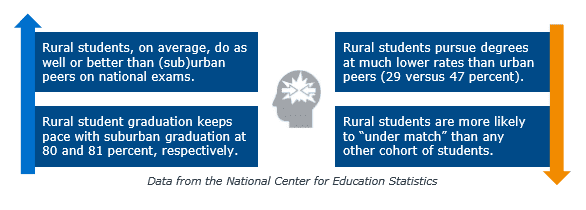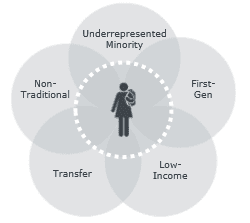In December 2018, the Marketing and Recruiting Effectiveness Center (MREC) convened several cohorts of higher education professionals to share their challenges and explore emerging trends in rural student recruitment and support.
This briefing is a synthesis of the six most pressing issues that emerged across this series of conversations. These challenges surfaced across member institutions of all sizes and selectivity levels, and more than 20 states across the U.S. were represented. The MREC team will use these member-generated top issues to form the basis of our current research initiative on rural student issues.
Use this briefing to:
- Shed light on the current context institutions are operating in when recruiting rural students
- Identify shared challenges in rural student support
- Kickstart conversations on campus with key stakeholders regarding rural efforts
6 challenges make it difficult for enrollment teams to recruit and support rural students:
1. Meeting an unfunded mandate
Many schools feel the pressure of institutional, system, or state mandates to recruit and serve rural students but must meet new goals without additional funds or resources. Keep reading.
2. Creating and maintaining effective partnerships
Limited resources make outreach to expansive, thinly populated rural regions nearly impossible to scale without partnerships: Explore this section to learn how partnering with grant organizations, other institutions, and community and business groups helps amplify the reach of higher education in rural communities. Keep reading.
Explore this section to learn how partnering with grant organizations, other institutions, and community and business groups helps amplify the reach of higher education in rural communities. Keep reading.
3. Getting a foot in the door in rural communities
Tight-knit rural communities pose unique recruitment challenges, from the need for sustained presence to the difficulty of initially breaking in. Keep reading.
4. Addressing attainability concerns
Rural students and their families—even when they aspire to higher education—often feel that a degree is unattainable for financial and/or academic reasons. This drives lower levels of degree seeking among rural students compared to the national average:
 Explore this section to see how concerns about academic inferiority and finances can dissuade rural students from considering higher education. Keep reading.
Explore this section to see how concerns about academic inferiority and finances can dissuade rural students from considering higher education. Keep reading.
5. Supporting career planning and counseling needs
Rural students may not see how higher education can support their career aspirations, and it is difficult to find relevant guidance in their communities. Keep reading.
6. Managing rural students’ first-year transition

Schools must determine how best to identify the adjustment challenges rural students are facing and connect them with appropriate resources. Existing support services and programming on campus may serve rural students well, as rural students may be similar to many other types of students.
Explore this section to discover how characteristics of rural students may overlap with other student populations and what common adjustment challenges may warrant dedicated programming for rural students. Keep reading.
Want more on this topic?
This briefing is the first in a series of resources on recruiting rural students that our research team is currently working on. In the meantime, check out the suite of marketing and recruiting resources MREC has produced to serve enrollment teams. Access the MREC library.